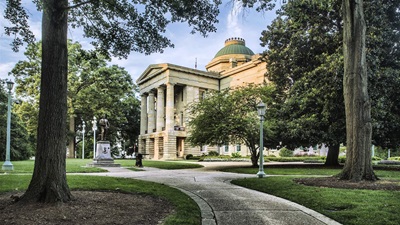Amid Colorado Overdose Deaths, State Legislature Supports Naloxone in Schools
State Senator Cleave Simpson explains why making an opioid overdose reversal drug more available matters
Despite declining drug overdose deaths in the U.S., opioids such as fentanyl are still driving most of these fatalities across the country. But naloxone is a lifesaving medication that can help. Any person, even those without medical training, can administer naloxone to someone in need and reverse an opioid overdose.
As a farmer and rancher in rural Colorado, State Senator and Minority Leader Cleave Simpson—a Republican representing District 6, the southwest region covering Alamosa, Durango, Telluride, and other cities—knew the overdose crisis was taking a toll on his community. But when he joined the Colorado Senate in 2021, he realized the devastation had rippled across the state, and that the Legislature needed to act. Last year, Governor Jared Polis (D) signed legislation championed by Senator Simpson that makes naloxone available in school settings.
This interview has been edited for length and clarity.
Help us understand what the overdose crisis looks like in both your district and Colorado today.
I was born and raised in rural Colorado. Five years ago, I didn’t grasp the magnitude of the overdose problem. We often heard anecdotes about families losing people to opioids, but I never would have had a conversation about the dangers of fentanyl. But today, in large part because of fentanyl, rural communities across Colorado are feeling the very real effects of the overdose crisis—and my Senate district is proof of that.
What have you learned about the overdose crisis since being elected?
I don’t mean to oversimplify, but Colorado doesn’t have enough physical space to treat people for substance use disorder. We don’t have a workforce to support them, and we don’t do enough in preventive care. In 2021, the Legislature set aside $550 million to transform the behavioral health field, but that money has not stemmed the tide or improved outcomes for people.
You’ve helped pass legislation to address the overdose crisis. What does H.B. 24-1003 do?
This bill allows schools in Colorado to keep naloxone on site and available to students in need and also makes it available on school buses.
The bill originated with a group of young people in Durango in my district. They lost a fellow student to drugs that were laced with fentanyl, and they felt helpless when he died. But his death was also a motivating force for them.
Why did you push for this bill?
When I first read the bill, my gut was telling me this feels like surrender, like we’re just giving in to this problem of substance use disorder. But I thought about it a bit more, and I realized it’s also our reality. And hearing from these kids who were asking for help—it became easy. I thought, what could be the harm in making naloxone more available to kids who may need it? I think it will help.
How did you build support for the bill?
Thankfully, support from across the political aisle was already there, in large part because of the students’ drive, ambition, and leadership. I didn’t have to push my colleagues. And no constituent ever called me and said, “How dare you support making naloxone more accessible in school.”
But I will say, I wondered if legislation like this would have been possible 10 years earlier. I think it would have been a much more difficult, controversial conversation.
How do you mean?
Today, we’ve become so accustomed to the influence of fentanyl in our society. I think it’s softened people’s perspectives and forced them to consider what tools we can use to combat this problem. And that includes making naloxone more readily available, especially to young people.
What effects have you seen from the legislation?
I don’t have any specific stories to share, but I do know the kids in Durango were very appreciative. And I do believe this bill can help with visibility. I keep naloxone in my office at the Capitol, in full view of everybody that comes in. That’s very intentional on my part, to help relieve some of the stigma.
I do hope that this legislation will be helpful, which is difficult for me to say—because it’s bad news if someone needs naloxone, but good news if it can help someone, especially our younger folks in schools. It’s a consolation to know we’ve done something to protect them.
What else can Colorado legislators do to address the overdose crisis?
My entire motivation as a senator has been to try and make life better for my constituents and all Coloradans. Over the past five years, we’ve passed close to 20 bills to address substance use disorders. But we’re not moving the needle or seeing different outcomes. We’re trying to do the right thing but we’re failing our constituents.
I’m at a loss for where to go next. What can I do as a legislator other than try to work with agencies, like Colorado’s Behavioral Health Administration, that know and understand this issue and can maybe craft a different outcome? That’s a bit of a cop out for a politician, but I wish I knew how to fix it.
Any final thoughts?
It’s not hard to be motivated by this issue—you’ll be hard-pressed to find any legislator or Coloradan that isn’t impacted by substance use disorder. I always try to be open-minded and engaged. In fact, two years ago, I toured a harm reduction center in Denver about 10 blocks from the Capitol. I found myself so out of my wheelhouse—but it was an amazing several hours being able to see the kind of resources that might be available to people in need.












